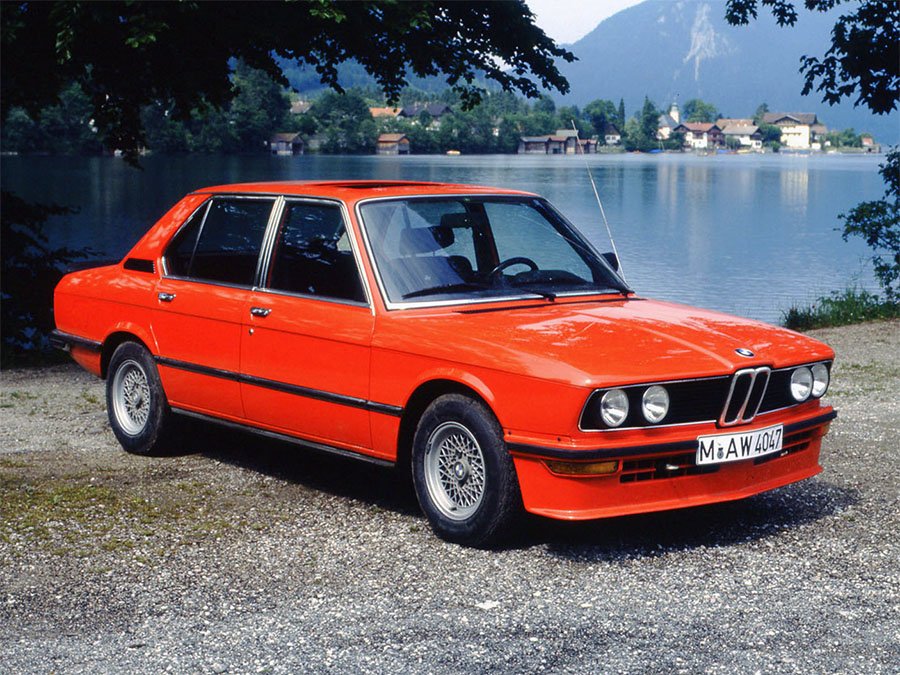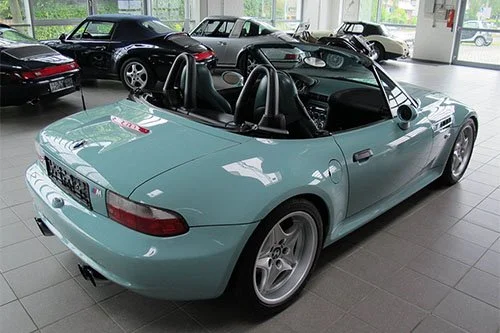Guide: BMW E12 M535i
Background
In the years following BMW Motorsport’s late 1971 inception, the specialist facility on the outskirts of Munich developed and raced a number of models on behalf of its parent company.
First to arrive was the E9-based 3.0 CSL Coupe, a homologation special created so a Group 2 racing version could compete in the 1973 European Touring Car Championship (that BMW duly won). Unfortunately, as a result of the Oil Crisis that kicked off in late 1973, BMW decided to abandon plans for a factory racing effort with the CSL in 1974.
The Oil Crisis also greatly reduced demand for BMW Motorsport’s second high performance special: the diminutive E20 2002 Turbo.
After production of the 2002 Turbo was discontinued in December 1973, BMW Motorsport turned their attention to the mid-range E12 5-series sedan.
Launched at the Frankfurt Motor Show in September 1972, the E12 was BMW’s first generation 5-series. It sat between the entry level 2002 (which became the E21 3-series in 1975) and the larger E9 Coupe and E3 Saloon (which respectively became the E24 6 series in 1976 and the E23 7-series in 1977).
The E12 was initially available with four cylinder engines of 1.8 and 2.0-litres. The range was expanded to include a 2.5-litre six cylinder motor from 1973 and a 2.8 from 1974.
In 1974, BMW Motorsport began to offer their own interpretations of the straight six-powered E12 5-series. These uprated machines were created for customers that wanted the ultimate sports saloon of its day.
At the time, the most potent series production E12 was the 163bhp 528.
As an alternative, by special order customers could upgrade to the Motorsport 530 (which used the 180bhp carb-fed engine from the BMW 3.0 S) or the Motorsport 530i (which came with the fuel-injected 200bhp engine from BMW 3.0 Si).
Both variants were further enhanced with stiffer springs and dampers, wider BBS wheels, a shorter rear axle ratio and a limited-slip differential. Externally, cars could be accessorised with a BMW Motorsport stripe kit. Cockpits were typically fitted with either Scheel or Recaro seats and a small diameter BMW Motorsport three-spoke steering wheel.
For the 1976 racing season, BMW Motorsport developed the E12-based 530 MLE (Motorsport Limited Edition). The 530 MLE was created at the request of BMW South Africa who wanted to homologate a tricked out 5-series with a three-litre engine for touring car racing.
Assembly of these cars took place at BMW’s Rosslyn plant near Pretoria. They came with lightened body panels, a hot engine, close-ratio Getrag gearbox, uprated suspension, flared wheelarches, a spoiler kit and several interior enhancements.
Although only 100 examples were required for homologation, 227 examples of the 530 MLE were ultimately built, all of which were destined for the South African market.
In 1976, BMW Motorsport also began to offer their European customers a 197bhp Motorsport 533i which used the engine from the new E26 633 CSi 6-series.
Production of the various Motorsport 5-series continued until late 1979, by which time around 900 examples had been built.
Having proven there was a reasonably sized market for a hot 5-series, BMW finally decided to offer an official Motorsport-tuned variant that was openly available through their main dealer network (although not those in the USA because it did not meet safety or emissions standards and to comply would have significantly reduced performance levels).
The resultant E12 M535i was unveiled at the Frankfurt Motor Show in September 1979. It came with a BMW Motorsport-tuned chassis and an array body enhancements. In the engine bay was the 3.5-litre straight six from the 735i and 635 CSi.
Each car was partially assembled on the normal 5-series production line at Dingolfing and then hand-finished at the BMW Motorsport facility in Garching. Production began in April 1980.
Chassis
Like all E12s, the M535i was based on a pressed steel monocoque bodyshell with a 2636mm wheelbase.
The existing MacPherson strut / semi-trailing arm suspension layout was uprated with stiffer springs and Bilstein shocks. Thicker anti-roll bars were fitted at either end.
280mm ventilated front brakes discs were the same diameter as the standard 5-series, but the discs were now 3mm thicker (25mm). Solid rear discs with a 272mm diameter were imported straight from the regular 5-series.
At this stage, ABS was not fitted to any E12s, but the brakes were servo-assisted.
BMW’s speed-sensitive power steering system was retained.
To increase grip levels and give a sportier appearance, the M535i was equipped with handsome 14 x 6.5-inch BBS cross-spoke alloy wheels. These were originally shod with Michelin XWX tyres. Track was 33mm wider at the rear axle.
A 70-litre fuel tank was located in the trunk floor.
Engine / Gearbox
The Type M30B35LE engine fitted to the M535i used the same cast-iron block as the M88 unit found in the E26 M1.
However, instead of a dual overhead camshaft head with four valves per cylinder, the M535i motor incorporated a single overhead camshaft and two valves per cylinder. It also used wet instead of dry-sump lubrication and Bosch L-Jetronic fuel-injection as opposed to the M1’s Kugelfischer system.
Both engines displaced 3453cc thanks to a bore and stroke of 93.4mm and 84mm respectively.
The compression ratio was 9.3:1 (up from 9.0:1 on the M1).
Output figures were 215bhp at 5200rpm and 224lb-ft at 4000rpm. For comparison, the M1 pumped out 277bhp at 6500rpm and 239lb-ft at 5000rpm.
As per the 530 MLE, transmission was via a close-ratio Getrag 265 five-speed manual dogleg gearbox, a single-plate clutch and Borg Warner limited-slip differential.
Bodywork
BMW Motorsport equipped the original Paul Bracq-designed body with a number of enhancements that gave the car a more purposeful appearance.
At the front was a deep body coloured front spoiler that wrapped around to the front wheelarches.
At the back, a black rubber lip spoiler was fixed to the trunk lid.
BMW Motorsport stripes were added down each flank and to the front spoiler.
The front grille was home to a BMW Motorsport badge on the right-hand side and a 535i badge on the left-hand side.
For those customers that wanted a more discrete appearance, any of all of these features could be deleted at no cost.
Interior
Inside, BMW Motorsport installed a pair of Recaro sport seats that were upholstered in corduroy fabric.
A three-spoke leather-rimmed steering wheel from the M1 was also fitted.
The rest of the M535i cockpit was standard E12.
A soft-touch plastic dash was home to a simple curved binnacle that contained a large speedometer alongside a matching rev counter. Smaller read outs for fuel and water temperature were located either side of the main dials and angled inwards towards the driver.
The centre console was home to the ventilation controls and a clock, below which was the audio system and an oddments tray.
Ergonomics, comfort and visibility were excellent.
Options
An array of optional extras were available, some of which were fitted on the Dingolfing production line and others at BMW Motorsport in Garching.
For the exterior, buyers could specify metallic paint, headlight wash / wipe, a passenger-side exterior mirror and fog lights. Fog lights were not compatible with the aforementioned spoiler kit.
The list of interior enhancements was much longer. It included leather or leatherette upholstery, ASS sports seats in black cloth with a central Motorsport stripe, electric windows (all round or front only), air-conditioning, central locking, a height-adjustable passenger seat, tinted glass, a manual or electric sunroof, velour floor mats, a fire extinguisher, rear head rests, a choice of audio systems, an electric aerial and a set of luggage.
Certain importers decided to bundle a package of options onto their cars as standard. For example, those vehicles destined for the UK were automatically equipped to quite a high specification. Right-hand drive production began three months after left-hand drive iterations (in July 1980).
Weight / Performance
Despite its bigger 3.5-litre engine, the M535i tipped the scales at just 6kg more than the 528 (1391kg compared to 1385kg).
0-62mph took 7 seconds and top speed was 142mph.
End of Production
In a little over a year, BMW Motorsport completed 1410 examples of the M535i.
Left-hand drive production ran from April 1980 to May 1981. 960 were built.
Right-hand drive production ran from July 1980 to May 1981. 450 were built.
South African Versions
In addition to these 1410 cars that were hand-finished at BMW Motorsport in Germany, BMW South Africa offered their own iteration assembled at the Rosslyn plant from Complete Knock Down kits sent over from Europe.
These cars were fitted with wider 7 x 14-inch BBS wheels but did not come with spoilers or stripes.
Front fog lights were standard along with air-conditioning, electric windows, central locking and a Getrag overdrive manual gearbox. The Euro version dogleg Getrag close-ratio ‘box was available as an option.
Production of these first series South African variants ran from February 1981 to July 1981. 240 were built, all of which were right-hand drive.
An updated South African M535i was then offered as part of the E12 / E28 range between 1981 and 1984.
These E12 / E28 hybrids retained the older E12 body and mechanicals but came with an updated interior that featured many of the components from the newer E28 5-series which wasn’t available in South Africa until 1985.
The specification included the newer E28 dash and instrument cluster along with the new control panel located above rear view mirror. Door panels were also sourced from the E28, to which the old E12 armrests were initially fitted.
The Recaro seats now came with houndstooth fabric centres and leatherette sides as standard.
The only other change was unique metric-sized wheels (165mm x 390mm) which ran on Michelin’s corresponding TRX tyres.
1416 of these hybrid variants were built for the South African market between September 1981 and December 1984, all of which were right-hand drive.
Text copyright: Supercar Nostalgia
Photo copyright: BMW - https://www.bmw.com











































